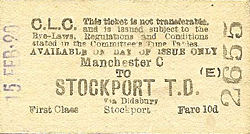 Notes: Stockport Tiviot Dale was opened by the Stockport, Timperley and Altrincham Junction Railway (ST&AJR) on 1st December1865 as Stockport Teviot Dale. The station was located on an extension of the Stockport & Woodley Junction Railway’s (S&WJR) Woodley to Stockport Portwood line from Stockport Portwood to a junction with the Cheshire Midlands Northwich Junction line at what became Skelton Junction. By18th July 1865 both the ST&AJR and the S&WJR, along with a number of other small independent lines in the area, were formally absorbed into the Cheshire Lines Committee (CLC). The CLC was initially made up from the Manchester, Sheffield and Lincolnshire Railway (MSLR) and the Great Northern Railway (GNR). On 18th July 1866 the Midland Railway (MR) also joined the group as an equal partner. Notes: Stockport Tiviot Dale was opened by the Stockport, Timperley and Altrincham Junction Railway (ST&AJR) on 1st December1865 as Stockport Teviot Dale. The station was located on an extension of the Stockport & Woodley Junction Railway’s (S&WJR) Woodley to Stockport Portwood line from Stockport Portwood to a junction with the Cheshire Midlands Northwich Junction line at what became Skelton Junction. By18th July 1865 both the ST&AJR and the S&WJR, along with a number of other small independent lines in the area, were formally absorbed into the Cheshire Lines Committee (CLC). The CLC was initially made up from the Manchester, Sheffield and Lincolnshire Railway (MSLR) and the Great Northern Railway (GNR). On 18th July 1866 the Midland Railway (MR) also joined the group as an equal partner.
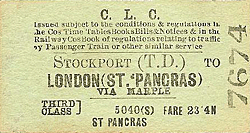 The station was located on the east side of a main thoroughfare called Lancashire Hill, close to the centre of Stockport. The main station building was on the south side of the line, and it was approached from a road that led down from Teviot Dale. The building was a large brick-built structure that consisted of a two storey centre with single storey wings. A series of archways supported a canopy roof along the entire length of the building adjacent to the approach road, giving shelter to passengers waiting for cabs or omnibuses. The station was located on the east side of a main thoroughfare called Lancashire Hill, close to the centre of Stockport. The main station building was on the south side of the line, and it was approached from a road that led down from Teviot Dale. The building was a large brick-built structure that consisted of a two storey centre with single storey wings. A series of archways supported a canopy roof along the entire length of the building adjacent to the approach road, giving shelter to passengers waiting for cabs or omnibuses.
There were two through platforms. The main station building stood on the westbound platform. This platform was provided with generous canopies that provided a good amount of shelter but also made the station seem a little gloomy. A covered footbridge passed over four tracks, two of which did not have platforms as they were provided for through trains, and connected to the eastbound platform. On the eastbound platform there was another substantial brick building and an extensive canopy.
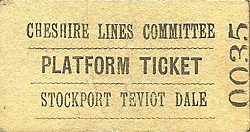 At the west end of the station the line passed immediately into a tunnel, and the ramps at the west end of both through platforms extended right up to the tunnel mouth. On the eastbound platform, adjacent to the tunnel, there was a signal box called Teviot Dale West. A bell, fixed to the tunnel wall next to the signal box, was rung to let station staff know when a train was approaching. At the west end of the station the line passed immediately into a tunnel, and the ramps at the west end of both through platforms extended right up to the tunnel mouth. On the eastbound platform, adjacent to the tunnel, there was a signal box called Teviot Dale West. A bell, fixed to the tunnel wall next to the signal box, was rung to let station staff know when a train was approaching.
At the eastern end of the westbound platform there were two bay platforms for terminating trains from the east. The platforms were provided with an overall roof. At the eastern end of the eastbound platform there was a single bay platform. In all, the station had five platform faces. An engine shed, complete with turntable, was located on the north side of the station.
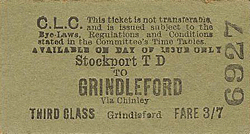 At first train services were mostly of a local nature, running eastbound towards Woodley and onwards via MSLR lines to the LNWR terminus at Manchester London Road, or westwards towards Northwich - or even Liverpool via the a route through Warrington Arpley. The CLC’s owning companies, though, saw the strategic possibilities of the line through Stockport Tiviot Dale, and in the late 1860s they obtained Acts that would have a significant impact on the station. On 1st August 1873 the CLC opened a line from Skelton Junction to Garston (near Liverpool) for passenger services. This gave the CLC a main line from Liverpool to Woodley from where trains could travel onwards to the MSLR main line across the Pennines to Sheffield. On 15th February 1875 a spur was opened from Bredbury, which lies to the east of Stockport, to Romiley. This gave a connection to the MR’s main line to London via Matlock and Derby. On 1st April 1875 the MR started to run express services between London St Pancras and Liverpool Central, and these trains stopped at Stockport Tiviot Dale. At first train services were mostly of a local nature, running eastbound towards Woodley and onwards via MSLR lines to the LNWR terminus at Manchester London Road, or westwards towards Northwich - or even Liverpool via the a route through Warrington Arpley. The CLC’s owning companies, though, saw the strategic possibilities of the line through Stockport Tiviot Dale, and in the late 1860s they obtained Acts that would have a significant impact on the station. On 1st August 1873 the CLC opened a line from Skelton Junction to Garston (near Liverpool) for passenger services. This gave the CLC a main line from Liverpool to Woodley from where trains could travel onwards to the MSLR main line across the Pennines to Sheffield. On 15th February 1875 a spur was opened from Bredbury, which lies to the east of Stockport, to Romiley. This gave a connection to the MR’s main line to London via Matlock and Derby. On 1st April 1875 the MR started to run express services between London St Pancras and Liverpool Central, and these trains stopped at Stockport Tiviot Dale.
The station was provided with a 2-road engine shed which was opened on 1st February 1866 by the Stockport, Timperley & Altrincham Junction Railway. It was closed and partly demolished in March 1889, leaving the rear of shed which supported water tank and turntable etc., as a loco stabling point; this survived until the end of steam.
The spelling 'Teviot' Dale was used in MR timetables prior to July 1874 and in Bradshaw timetables until 1876 (after which it was listed as Tiviot Dale). 'Teviot Dale' continued to appear on tickets until at least 1906. Stockport Town officials referred to the station as Stockport Tiviot Dale from the very start.
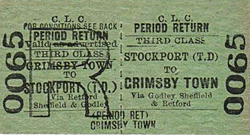 From the 1860s onwards the LNWR had been hostile to the MR as it feared the competition of alternative routes. The LNWR made it increasingly difficult for the MR to operate express services into and out of Manchester London Road. The MR had aspirations to create a terminus station of their own in Manchester, and they spotted an opportunity in 1873. An Act was granted to the Manchester South District Railway (MSDR) to build a line from Manchester to Heaton Mersey, which lay to the west of Stockport. The MSDR struggled financially, so the MR took it over in 1877, built the line connecting it to the CLC line at Heaton Mersey, and it opened on 1st January 1880. The MR could now run trains directly into Manchester without relying on the LNWR. At first its trains ran into a temporary terminus at Manchester Central, but from 1st July 1880 they were able to use the new CLC Manchester Central station, which was arguably second only to London St Pancras in size and scale. From the 1860s onwards the LNWR had been hostile to the MR as it feared the competition of alternative routes. The LNWR made it increasingly difficult for the MR to operate express services into and out of Manchester London Road. The MR had aspirations to create a terminus station of their own in Manchester, and they spotted an opportunity in 1873. An Act was granted to the Manchester South District Railway (MSDR) to build a line from Manchester to Heaton Mersey, which lay to the west of Stockport. The MSDR struggled financially, so the MR took it over in 1877, built the line connecting it to the CLC line at Heaton Mersey, and it opened on 1st January 1880. The MR could now run trains directly into Manchester without relying on the LNWR. At first its trains ran into a temporary terminus at Manchester Central, but from 1st July 1880 they were able to use the new CLC Manchester Central station, which was arguably second only to London St Pancras in size and scale.
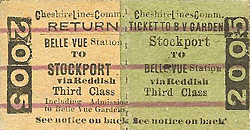 From 1880 Stockport Tiviot Dale station was served by long distance express services running between the cities of Liverpool and Manchester to destinations such as Bristol, London, Nottingham and Hull. Other services ran to Chester, Warrington, Buxton, Derby and Sheffield. Local commuter services operated at a high frequency between Manchester Central andStockport Tiviot Dale. Other local services ran eastwards to Woodley and Godley, and onwards to Manchester London Road. Train services were provided by the three owning companies of the CLC and by the CLC in its own right; although the CLC never owned any locomotives of its own, they were provided by the MSLR. From 1880 Stockport Tiviot Dale station was served by long distance express services running between the cities of Liverpool and Manchester to destinations such as Bristol, London, Nottingham and Hull. Other services ran to Chester, Warrington, Buxton, Derby and Sheffield. Local commuter services operated at a high frequency between Manchester Central andStockport Tiviot Dale. Other local services ran eastwards to Woodley and Godley, and onwards to Manchester London Road. Train services were provided by the three owning companies of the CLC and by the CLC in its own right; although the CLC never owned any locomotives of its own, they were provided by the MSLR.
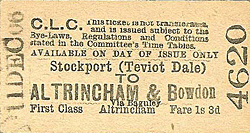 The situation at Stockport Tiviot Dale remained the same for over twenty years. The desire for speed, and the keen sense of competition between the MR and the LNWR, led the MR to consider ways in which it could accelerate its southbound express trains. The solution was to build a direct line between New Mills and Heaton Mersey at a cost of £2 million. The new linewould cut out the need for trains to run via Stockport Tiviot Dale, thereby allowing express services to substantially improve journey times between London St Pancras and Manchester and Liverpool. The situation at Stockport Tiviot Dale remained the same for over twenty years. The desire for speed, and the keen sense of competition between the MR and the LNWR, led the MR to consider ways in which it could accelerate its southbound express trains. The solution was to build a direct line between New Mills and Heaton Mersey at a cost of £2 million. The new linewould cut out the need for trains to run via Stockport Tiviot Dale, thereby allowing express services to substantially improve journey times between London St Pancras and Manchester and Liverpool.
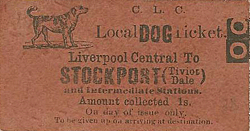 The new line was authorised in 1898, and work began immediately. Despite the need for some very heavy engineering, including the construction of a two-mile long tunnel at Disley, the line was ready for use by 1st July 1902. Because most express services would no longer pass through Tiviot Dale a new station was opened on the new line at Cheadle Heath, which lay to the west of Stockport. On 1st July 1902 most main line services began to use Cheadle Heath, and Stockport Tiviot Dale lost its importance as a main line station. Although it was still served by many trains, it would never again be anything other than a secondary station as far as main line services were concerned. The new line was authorised in 1898, and work began immediately. Despite the need for some very heavy engineering, including the construction of a two-mile long tunnel at Disley, the line was ready for use by 1st July 1902. Because most express services would no longer pass through Tiviot Dale a new station was opened on the new line at Cheadle Heath, which lay to the west of Stockport. On 1st July 1902 most main line services began to use Cheadle Heath, and Stockport Tiviot Dale lost its importance as a main line station. Although it was still served by many trains, it would never again be anything other than a secondary station as far as main line services were concerned.
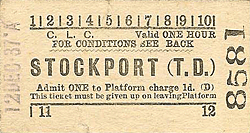 In 1899 the MSLR changed its name to the Great Central Railway (GCR). During the early part of the 20th century passenger train services from Stockport Tiviot Dale operated to Buxton Midland, Derby, Liverpool Central, London St Pancras, London Marylebone, Manchester Central, Nottingham, Sheffield Midland and Southport Lord Street. The most intensive service was the local all-stations to Manchester Central. Trains ran approximately every 20 minutes between Stockport and Manchester. In 1899 the MSLR changed its name to the Great Central Railway (GCR). During the early part of the 20th century passenger train services from Stockport Tiviot Dale operated to Buxton Midland, Derby, Liverpool Central, London St Pancras, London Marylebone, Manchester Central, Nottingham, Sheffield Midland and Southport Lord Street. The most intensive service was the local all-stations to Manchester Central. Trains ran approximately every 20 minutes between Stockport and Manchester.
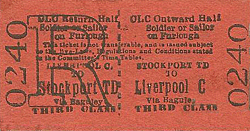 In 1923 the CLC remained as an independent company, but its share owners became the London Midland Scottish Railway (LMS) who held a third share, and the London North Eastern Railway (LNER) who held two thirds of the shares. From this date the CLC train services were all hauled by LNER engines. During the 1920s and 1930s an intensive commuter service continued to operate to Manchester Central, but eastbound trains to Woodley declined dramatically. Many excursion trains ran from Tiviot Dale in this period taking residents of Stockport to Chester, Southport, New Brighton (via the ferries at Liverpool) and to Buxton and the Peak District. Indeed, in the 1930s ramblers’ specials to the Peak District became very popular. In 1923 the CLC remained as an independent company, but its share owners became the London Midland Scottish Railway (LMS) who held a third share, and the London North Eastern Railway (LNER) who held two thirds of the shares. From this date the CLC train services were all hauled by LNER engines. During the 1920s and 1930s an intensive commuter service continued to operate to Manchester Central, but eastbound trains to Woodley declined dramatically. Many excursion trains ran from Tiviot Dale in this period taking residents of Stockport to Chester, Southport, New Brighton (via the ferries at Liverpool) and to Buxton and the Peak District. Indeed, in the 1930s ramblers’ specials to the Peak District became very popular.
During the Second World War passenger services were reduced at Stockport Tiviot Dale to allow more freight trains and troop trains to run.
After the war things returned to normal, but the service to Woodley had been discontinued. On 1st January 1948 the Stockport Tiviot Dale station became part of the nationalised British Railways (London Midland Region) and the CLC ceased to exist.
During the 1950s competition from road transport began to take its toll on the services at Stockport Tiviot Dale. The overall roof over the bay platforms at the east end of the westbound platform was removed. Passenger trains had ceased to use these platforms anyway by the 1940s. In 1962 the station was left with one service per day to London St Pancras; a Liverpool Central to Nottingham express; only five local trains in each direction between either Liverpool Central or Warrington Central and Tiviot Dale via Skelton Junction; five services to Sheffield; and five to Derby. A more regular service, but nothing like it had been in the past, continued to link Stockport Tiviot Dale and Manchester Central.
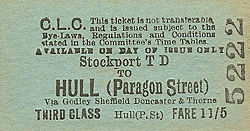 On 30th November 1964 the Liverpool Central / Warrington Central and Stockport Tiviot Dale service was withdrawn. In 1966 main line services stopped operating from Liverpool Central, and Stockport Tiviot Dale lost its Nottingham service. With only a handful of services left Stockport Tiviot Dale station was closed completely on 2nd January 1967. On 30th November 1964 the Liverpool Central / Warrington Central and Stockport Tiviot Dale service was withdrawn. In 1966 main line services stopped operating from Liverpool Central, and Stockport Tiviot Dale lost its Nottingham service. With only a handful of services left Stockport Tiviot Dale station was closed completely on 2nd January 1967.
As soon as the station closed the rails were removed from the platforms leaving just two lines - the former through lines - to cater for the intensive goods service that still operated through the station site. In 1968 a demolition contractor, Messrs Dawson and Morris of Skipton, was appointed to remove the station buildings and structures; by 1969 only the platforms remained.
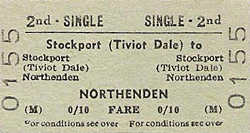 The line through Tiviot Dale was an important route for freight trains travelling between the Woodhead route and Liverpool, so it remained open throughout the 1970s and into the 1980s. Among the busiest freight services that continued to run through Stockport Tiviot Dale were the coal trains from South Yorkshire to Fiddlers Ferry Power Station near Warrington. With the closure of the Woodhead route in 1981 the line lost most of its traffic. In 1980 works in connection with the construction of the M63 motorway (later to become the M60 ring road) damaged the tunnel that passed under Lancashire Hill. The line was closed temporarily as a safety measure. By 1982 British Rail came to the conclusion that, having managed without the line for two years, they could dispense with it. The section of line from Heaton Mersey to Bredbury, including the section running through Tiviot Dale, closed completely in 1982, one track was lifted in 1983/4 the second in 1986. The tunnel at Tiviot Dale has now been partially filled with earth and rubble, and the station site is heavily overgrown, but sections of the bay platform still exist. The line through Tiviot Dale was an important route for freight trains travelling between the Woodhead route and Liverpool, so it remained open throughout the 1970s and into the 1980s. Among the busiest freight services that continued to run through Stockport Tiviot Dale were the coal trains from South Yorkshire to Fiddlers Ferry Power Station near Warrington. With the closure of the Woodhead route in 1981 the line lost most of its traffic. In 1980 works in connection with the construction of the M63 motorway (later to become the M60 ring road) damaged the tunnel that passed under Lancashire Hill. The line was closed temporarily as a safety measure. By 1982 British Rail came to the conclusion that, having managed without the line for two years, they could dispense with it. The section of line from Heaton Mersey to Bredbury, including the section running through Tiviot Dale, closed completely in 1982, one track was lifted in 1983/4 the second in 1986. The tunnel at Tiviot Dale has now been partially filled with earth and rubble, and the station site is heavily overgrown, but sections of the bay platform still exist.
Other web sites:Closed South Manchester Railways, The Hyde & Peak Railtour, Bike rides around the Greater Manchester area & Levenshulme then and now.
Further reading. The Fallowfield Line, EM Johnson 2000 Foxline Pub.ISBN187011969X
Tickets from Michael Stewart, route map drawn by Alan Young
To see other stations between Manchester Central & Cheadle Heath click on the station name: Manchester Central, Chorlton-cum-Hardy, Withington & West Didsbury, Didsbury, Heaton Mersey, Cheadle Heath
To see the other
stations on the Woodley - Glazebrook line click on the station
name: Stockport Portwood, Cheadle (Cheshire) , Northenden, Baguley, West Timperley, Partington (1st), Partington (2nd), Cadishead (1st) & Cadishead (2nd) |

tiviot_dale_old6.jpg)
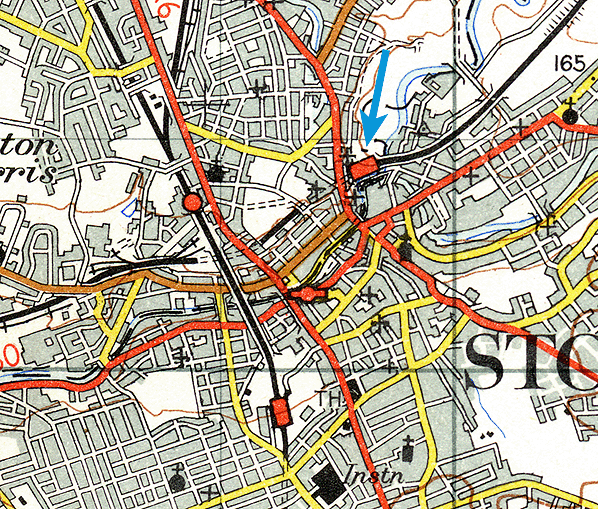
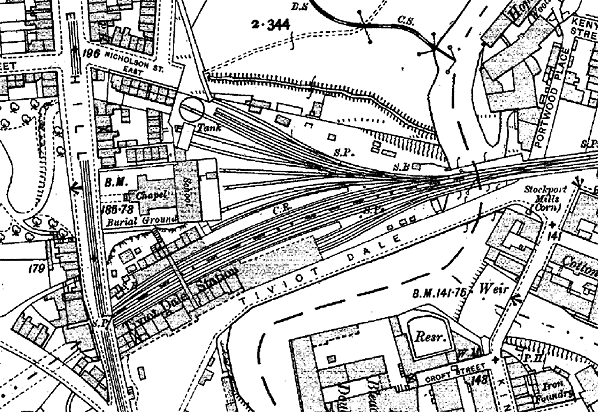
old4.jpg)
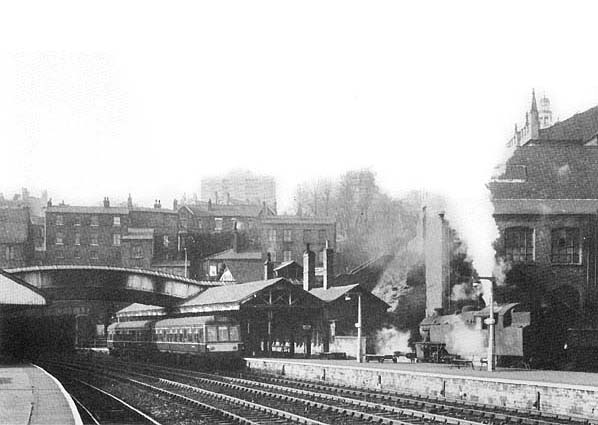
old3.jpg) Manchester
Central - Sheffield DMU at Stockport Tiviot Dale in 1964
Manchester
Central - Sheffield DMU at Stockport Tiviot Dale in 1964tiviot_dale_old7.jpg) The last day of steam at Heaton Mersey shed on 4th May 1968 when some of the engines were being transferred to Newton Heath shed. The train was made up of 9F92118, 8Fs 48319 & 48356 and ran via Stockport Tiviot Dale & Guide Bridge which by then was freight only to Guide Bridge. This view from the footplate of 92118 shows the convoy passing through the closed Tiviot Dale station
The last day of steam at Heaton Mersey shed on 4th May 1968 when some of the engines were being transferred to Newton Heath shed. The train was made up of 9F92118, 8Fs 48319 & 48356 and ran via Stockport Tiviot Dale & Guide Bridge which by then was freight only to Guide Bridge. This view from the footplate of 92118 shows the convoy passing through the closed Tiviot Dale station20.jpg) Stockport Tiviot Dale station looking north east in February 1983. The westbound platform is seen on the left, the white wall stands on the eastbound platform. The bay platform is the far side of the wall.
Stockport Tiviot Dale station looking north east in February 1983. The westbound platform is seen on the left, the white wall stands on the eastbound platform. The bay platform is the far side of the wall.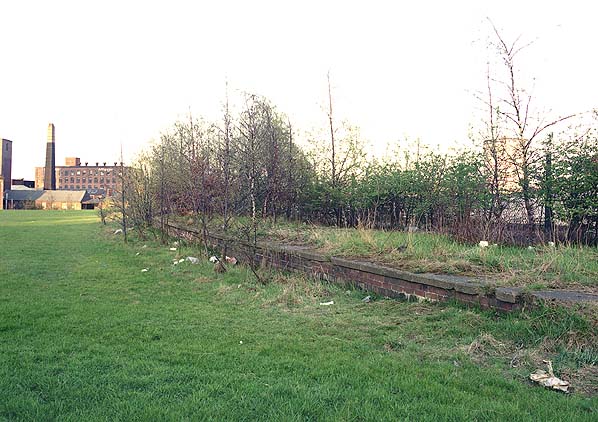 Stockport Tiviot Dale bay platform looking north east in April 1984
Stockport Tiviot Dale bay platform looking north east in April 198414.jpg) Stockport Tiviot Dale bay platform looking north east in November 2005, taken from a similar viewpoint to the picture above.
Stockport Tiviot Dale bay platform looking north east in November 2005, taken from a similar viewpoint to the picture above.15.jpg) looking east in April 2010 along the bay platform at Stockport Tiviot Dale station that was located on the north side of the eastbound platform. Most of the station site has been buried under earth but this platform edge survives in the undergrowth.
looking east in April 2010 along the bay platform at Stockport Tiviot Dale station that was located on the north side of the eastbound platform. Most of the station site has been buried under earth but this platform edge survives in the undergrowth. Notes: Stockport Tiviot Dale was opened by the Stockport, Timperley and Altrincham Junction Railway (ST&AJR) on 1st December1865 as Stockport Teviot Dale. The station was located on an extension of the Stockport & Woodley Junction Railway’s (S&WJR) Woodley to Stockport Portwood line from Stockport Portwood to a junction with the Cheshire Midlands Northwich Junction line at what became Skelton Junction. By18th July 1865 both the ST&AJR and the S&WJR, along with a number of other small independent lines in the area, were formally absorbed into the Cheshire Lines Committee (CLC). The CLC was initially made up from the Manchester, Sheffield and Lincolnshire Railway (MSLR) and the Great Northern Railway (GNR). On 18th July 1866 the Midland Railway (MR) also joined the group as an equal partner.
Notes: Stockport Tiviot Dale was opened by the Stockport, Timperley and Altrincham Junction Railway (ST&AJR) on 1st December1865 as Stockport Teviot Dale. The station was located on an extension of the Stockport & Woodley Junction Railway’s (S&WJR) Woodley to Stockport Portwood line from Stockport Portwood to a junction with the Cheshire Midlands Northwich Junction line at what became Skelton Junction. By18th July 1865 both the ST&AJR and the S&WJR, along with a number of other small independent lines in the area, were formally absorbed into the Cheshire Lines Committee (CLC). The CLC was initially made up from the Manchester, Sheffield and Lincolnshire Railway (MSLR) and the Great Northern Railway (GNR). On 18th July 1866 the Midland Railway (MR) also joined the group as an equal partner.
 The station was located on the east side of a main thoroughfare called Lancashire Hill, close to the centre of Stockport. The main station building was on the south side of the line, and it was approached from a road that led down from Teviot Dale. The building was a large brick-built structure that consisted of a two storey centre with single storey wings. A series of archways supported a canopy roof along the entire length of the building adjacent to the approach road, giving shelter to passengers waiting for cabs or omnibuses.
The station was located on the east side of a main thoroughfare called Lancashire Hill, close to the centre of Stockport. The main station building was on the south side of the line, and it was approached from a road that led down from Teviot Dale. The building was a large brick-built structure that consisted of a two storey centre with single storey wings. A series of archways supported a canopy roof along the entire length of the building adjacent to the approach road, giving shelter to passengers waiting for cabs or omnibuses.
 At the west end of the station the line passed immediately into a tunnel, and the ramps at the west end of both through platforms extended right up to the tunnel mouth. On the eastbound platform, adjacent to the tunnel, there was a signal box called Teviot Dale West. A bell, fixed to the tunnel wall next to the signal box, was rung to let station staff know when a train was approaching.
At the west end of the station the line passed immediately into a tunnel, and the ramps at the west end of both through platforms extended right up to the tunnel mouth. On the eastbound platform, adjacent to the tunnel, there was a signal box called Teviot Dale West. A bell, fixed to the tunnel wall next to the signal box, was rung to let station staff know when a train was approaching.
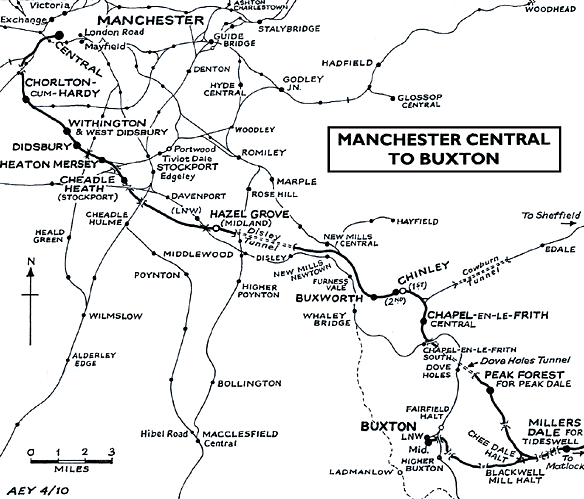
 At first train services were mostly of a local nature, running eastbound towards Woodley and onwards via MSLR lines to the LNWR terminus at Manchester London Road, or westwards towards Northwich - or even Liverpool via the a route through Warrington Arpley. The CLC’s owning companies, though, saw the strategic possibilities of the line through Stockport Tiviot Dale, and in the late 1860s they obtained Acts that would have a significant impact on the station. On 1st August 1873 the CLC opened a line from Skelton Junction to Garston (near Liverpool) for passenger services. This gave the CLC a main line from Liverpool to Woodley from where trains could travel onwards to the MSLR main line across the Pennines to Sheffield. On 15th February 1875 a spur was opened from Bredbury, which lies to the east of Stockport, to Romiley. This gave a connection to the MR’s main line to London via Matlock and Derby. On 1st April 1875 the MR started to run express services between London St Pancras and Liverpool Central, and these trains stopped at Stockport Tiviot Dale.
At first train services were mostly of a local nature, running eastbound towards Woodley and onwards via MSLR lines to the LNWR terminus at Manchester London Road, or westwards towards Northwich - or even Liverpool via the a route through Warrington Arpley. The CLC’s owning companies, though, saw the strategic possibilities of the line through Stockport Tiviot Dale, and in the late 1860s they obtained Acts that would have a significant impact on the station. On 1st August 1873 the CLC opened a line from Skelton Junction to Garston (near Liverpool) for passenger services. This gave the CLC a main line from Liverpool to Woodley from where trains could travel onwards to the MSLR main line across the Pennines to Sheffield. On 15th February 1875 a spur was opened from Bredbury, which lies to the east of Stockport, to Romiley. This gave a connection to the MR’s main line to London via Matlock and Derby. On 1st April 1875 the MR started to run express services between London St Pancras and Liverpool Central, and these trains stopped at Stockport Tiviot Dale. From the 1860s onwards the LNWR had been hostile to the MR as it feared the competition of alternative routes. The LNWR made it increasingly difficult for the MR to operate express services into and out of Manchester London Road. The MR had aspirations to create a terminus station of their own in Manchester, and they spotted an opportunity in 1873. An Act was granted to the Manchester South District Railway (MSDR) to build a line from Manchester to Heaton Mersey, which lay to the west of Stockport. The MSDR struggled financially, so the MR took it over in 1877, built the line connecting it to the CLC line at Heaton Mersey, and it opened on 1st January 1880. The MR could now run trains directly into Manchester without relying on the LNWR. At first its trains ran into a temporary terminus at Manchester Central, but from 1st July 1880 they were able to use the new CLC Manchester Central station, which was arguably second only to London St Pancras in size and scale.
From the 1860s onwards the LNWR had been hostile to the MR as it feared the competition of alternative routes. The LNWR made it increasingly difficult for the MR to operate express services into and out of Manchester London Road. The MR had aspirations to create a terminus station of their own in Manchester, and they spotted an opportunity in 1873. An Act was granted to the Manchester South District Railway (MSDR) to build a line from Manchester to Heaton Mersey, which lay to the west of Stockport. The MSDR struggled financially, so the MR took it over in 1877, built the line connecting it to the CLC line at Heaton Mersey, and it opened on 1st January 1880. The MR could now run trains directly into Manchester without relying on the LNWR. At first its trains ran into a temporary terminus at Manchester Central, but from 1st July 1880 they were able to use the new CLC Manchester Central station, which was arguably second only to London St Pancras in size and scale.  From 1880 Stockport Tiviot Dale station was served by long distance express services running between the cities of Liverpool and Manchester to destinations such as Bristol, London, Nottingham and Hull. Other services ran to Chester, Warrington, Buxton, Derby and Sheffield. Local commuter services operated at a high frequency between Manchester Central andStockport Tiviot Dale. Other local services ran eastwards to Woodley and Godley, and onwards to Manchester London Road. Train services were provided by the three owning companies of the CLC and by the CLC in its own right; although the CLC never owned any locomotives of its own, they were provided by the MSLR.
From 1880 Stockport Tiviot Dale station was served by long distance express services running between the cities of Liverpool and Manchester to destinations such as Bristol, London, Nottingham and Hull. Other services ran to Chester, Warrington, Buxton, Derby and Sheffield. Local commuter services operated at a high frequency between Manchester Central andStockport Tiviot Dale. Other local services ran eastwards to Woodley and Godley, and onwards to Manchester London Road. Train services were provided by the three owning companies of the CLC and by the CLC in its own right; although the CLC never owned any locomotives of its own, they were provided by the MSLR.  The situation at Stockport Tiviot Dale remained the same for over twenty years. The desire for speed, and the keen sense of competition between the MR and the LNWR, led the MR to consider ways in which it could accelerate its southbound express trains. The solution was to build a direct line between New Mills and Heaton Mersey at a cost of £2 million. The new linewould cut out the need for trains to run via Stockport Tiviot Dale, thereby allowing express services to substantially improve journey times between London St Pancras and Manchester and Liverpool.
The situation at Stockport Tiviot Dale remained the same for over twenty years. The desire for speed, and the keen sense of competition between the MR and the LNWR, led the MR to consider ways in which it could accelerate its southbound express trains. The solution was to build a direct line between New Mills and Heaton Mersey at a cost of £2 million. The new linewould cut out the need for trains to run via Stockport Tiviot Dale, thereby allowing express services to substantially improve journey times between London St Pancras and Manchester and Liverpool.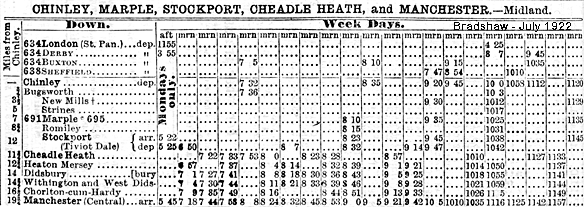
 The new line was authorised in 1898, and work began immediately. Despite the need for some very heavy engineering, including the construction of a two-mile long tunnel at Disley, the line was ready for use by 1st July 1902. Because most express services would no longer pass through Tiviot Dale a new station was opened on the new line at Cheadle Heath, which lay to the west of Stockport. On 1st July 1902 most main line services began to use Cheadle Heath, and Stockport Tiviot Dale lost its importance as a main line station. Although it was still served by many trains, it would never again be anything other than a secondary station as far as main line services were concerned.
The new line was authorised in 1898, and work began immediately. Despite the need for some very heavy engineering, including the construction of a two-mile long tunnel at Disley, the line was ready for use by 1st July 1902. Because most express services would no longer pass through Tiviot Dale a new station was opened on the new line at Cheadle Heath, which lay to the west of Stockport. On 1st July 1902 most main line services began to use Cheadle Heath, and Stockport Tiviot Dale lost its importance as a main line station. Although it was still served by many trains, it would never again be anything other than a secondary station as far as main line services were concerned.  In 1899 the MSLR changed its name to the Great Central Railway (GCR). During the early part of the 20th century passenger train services from Stockport Tiviot Dale operated to Buxton Midland, Derby, Liverpool Central, London St Pancras, London Marylebone, Manchester Central, Nottingham, Sheffield Midland and Southport Lord Street. The most intensive service was the local all-stations to Manchester Central. Trains ran approximately every 20 minutes between Stockport and Manchester.
In 1899 the MSLR changed its name to the Great Central Railway (GCR). During the early part of the 20th century passenger train services from Stockport Tiviot Dale operated to Buxton Midland, Derby, Liverpool Central, London St Pancras, London Marylebone, Manchester Central, Nottingham, Sheffield Midland and Southport Lord Street. The most intensive service was the local all-stations to Manchester Central. Trains ran approximately every 20 minutes between Stockport and Manchester. In 1923 the CLC remained as an independent company, but its share owners became the London Midland Scottish Railway (LMS) who held a third share, and the London North Eastern Railway (LNER) who held two thirds of the shares. From this date the CLC train services were all hauled by LNER engines. During the 1920s and 1930s an intensive commuter service continued to operate to Manchester Central, but eastbound trains to Woodley declined dramatically. Many excursion trains ran from Tiviot Dale in this period taking residents of Stockport to Chester, Southport, New Brighton (via the ferries at Liverpool) and to Buxton and the Peak District. Indeed, in the 1930s ramblers’ specials to the Peak District became very popular.
In 1923 the CLC remained as an independent company, but its share owners became the London Midland Scottish Railway (LMS) who held a third share, and the London North Eastern Railway (LNER) who held two thirds of the shares. From this date the CLC train services were all hauled by LNER engines. During the 1920s and 1930s an intensive commuter service continued to operate to Manchester Central, but eastbound trains to Woodley declined dramatically. Many excursion trains ran from Tiviot Dale in this period taking residents of Stockport to Chester, Southport, New Brighton (via the ferries at Liverpool) and to Buxton and the Peak District. Indeed, in the 1930s ramblers’ specials to the Peak District became very popular. 
 On 30th November 1964 the Liverpool Central / Warrington Central and Stockport Tiviot Dale service was withdrawn. In 1966 main line services stopped operating from Liverpool Central, and Stockport Tiviot Dale lost its Nottingham service. With only a handful of services left Stockport Tiviot Dale station was closed completely on 2nd January 1967.
On 30th November 1964 the Liverpool Central / Warrington Central and Stockport Tiviot Dale service was withdrawn. In 1966 main line services stopped operating from Liverpool Central, and Stockport Tiviot Dale lost its Nottingham service. With only a handful of services left Stockport Tiviot Dale station was closed completely on 2nd January 1967. The line through Tiviot Dale was an important route for freight trains travelling between the Woodhead route and Liverpool, so it remained open throughout the 1970s and into the 1980s. Among the busiest freight services that continued to run through Stockport Tiviot Dale were the coal trains from South Yorkshire to Fiddlers Ferry Power Station near Warrington. With the closure of the Woodhead route in 1981 the line lost most of its traffic. In 1980 works in connection with the construction of the M63 motorway (later to become the M60 ring road) damaged the tunnel that passed under Lancashire Hill. The line was closed temporarily as a safety measure. By 1982 British Rail came to the conclusion that, having managed without the line for two years, they could dispense with it. The section of line from Heaton Mersey to Bredbury, including the section running through Tiviot Dale, closed completely in 1982, one track was lifted in 1983/4 the second in 1986. The tunnel at Tiviot Dale has now been partially filled with earth and rubble, and the station site is heavily overgrown, but sections of the bay platform still exist.
The line through Tiviot Dale was an important route for freight trains travelling between the Woodhead route and Liverpool, so it remained open throughout the 1970s and into the 1980s. Among the busiest freight services that continued to run through Stockport Tiviot Dale were the coal trains from South Yorkshire to Fiddlers Ferry Power Station near Warrington. With the closure of the Woodhead route in 1981 the line lost most of its traffic. In 1980 works in connection with the construction of the M63 motorway (later to become the M60 ring road) damaged the tunnel that passed under Lancashire Hill. The line was closed temporarily as a safety measure. By 1982 British Rail came to the conclusion that, having managed without the line for two years, they could dispense with it. The section of line from Heaton Mersey to Bredbury, including the section running through Tiviot Dale, closed completely in 1982, one track was lifted in 1983/4 the second in 1986. The tunnel at Tiviot Dale has now been partially filled with earth and rubble, and the station site is heavily overgrown, but sections of the bay platform still exist. 

 Home Page
Home Page